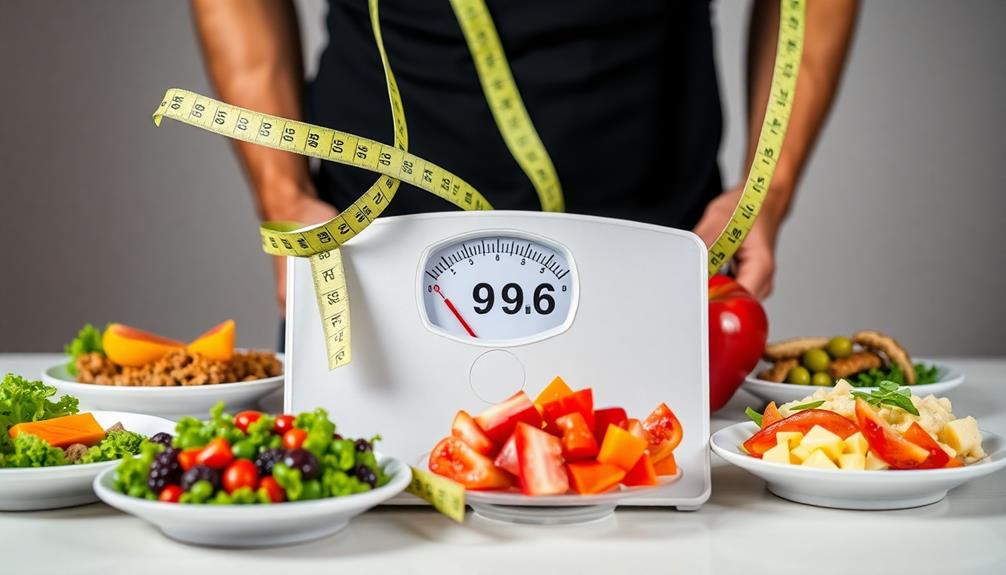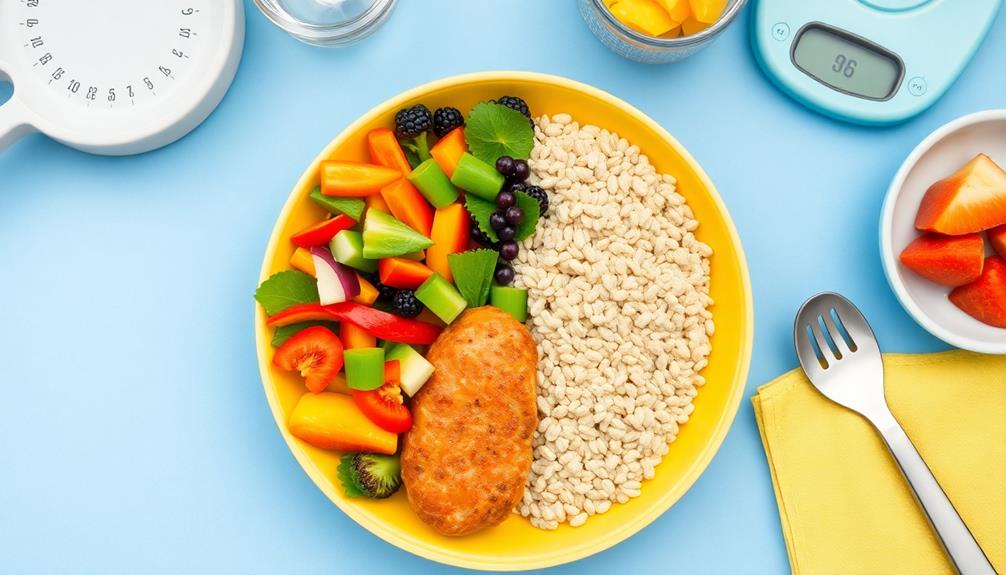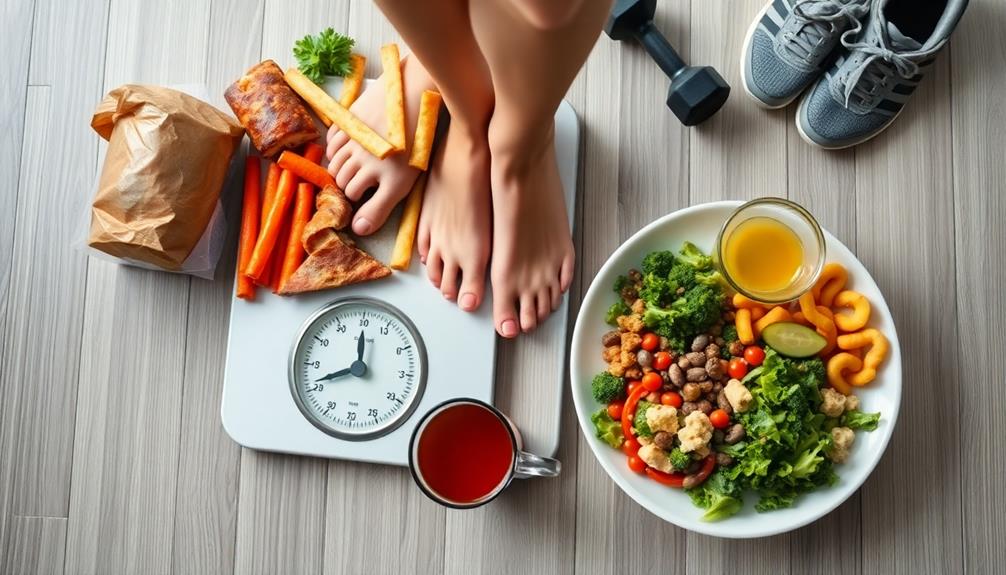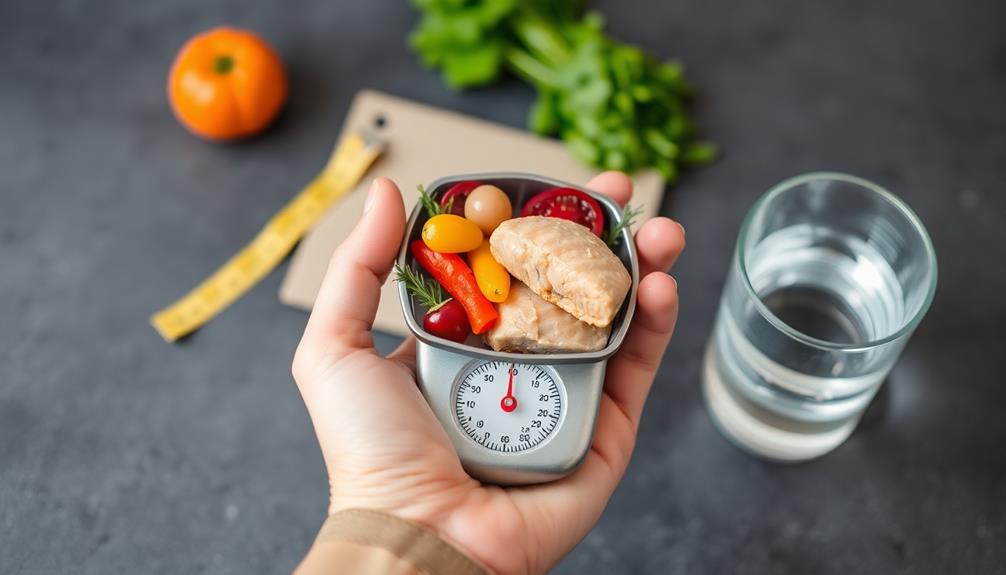To create a calorie deficit for effective cutting, start by calculating your Total Daily Energy Expenditure (TDEE). Aim for a modest 300-500 calorie deficit below your TDEE daily. Balance your macronutrients, increasing protein intake to preserve muscle while reducing carbs and fats. Plan your meals carefully, incorporating filling, low-calorie foods and using portion control techniques. Combine cardio and strength training exercises to boost calorie burning and maintain muscle mass. Track your progress using measurements and photos, and adjust your deficit as needed. Set realistic goals, aiming for 0.5-1 pound of weight loss per week. With patience and consistency, you'll uncover the keys to successful cutting.
Core Insight
- Calculate your Total Daily Energy Expenditure (TDEE) to determine your maintenance calorie level.
- Create a modest calorie deficit of 300-500 calories per day below your maintenance level.
- Increase protein intake to preserve muscle mass while cutting, aiming for 1.6-2.2 grams per kilogram of body weight.
- Plan meals and snacks in advance, focusing on nutrient-dense, low-calorie foods to stay satiated.
- Combine regular cardio and strength training exercises to boost calorie burning and support your cutting goals.
Understanding Calorie Deficits

Creating a calorie deficit is key for losing weight. This happens when you eat fewer calories than you burn in a day. As a result, your body uses stored fat for energy, causing weight loss. While in a calorie deficit, it's crucial to eat healthy and consider natural ways to support muscle.
To make a calorie deficit, you need to know your Total Daily Energy Expenditure (TDEE) – the calories you burn per day from basic functions and activity. Then, eat fewer calories than your TDEE.
Aim for a modest deficit of 300-500 calories daily for gradual, sustainable fat loss that preserves muscle. Avoid large deficits, which can break down muscle and slow your metabolism. Strike a balance for optimal results.
Calculating Your Maintenance Calories

To create an effective calorie deficit, you first need to know your maintenance calories – the calories your body needs to maintain your current weight. Here are three ways to figure this out:
- Use an online calculator. Enter your age, height, weight, and activity level to get a quick estimate.
- Track what you eat for 1-2 weeks while keeping your weight stable. This will show you how many calories you typically consume.
- Use the Harris-Benedict equation. This formula calculates your basal metabolic rate and factors in your activity level.
Once you know your maintenance calories, you can adjust your intake to create a deficit. It's like choosing the right supplements for building muscle – you need to consider your goals and find the right balance for the best results.
Setting Realistic Weight Loss Goals

Setting realistic weight loss goals is key to long-term success when cutting. Aim to lose 0.5 to 1 pound each week. This is a healthy rate that helps you keep muscle and avoid gaining weight back. Natural appetite suppressants can help, but talk to your doctor first.
Think about these things when setting goals:
- Your current body composition
- How fit you are and how much you exercise
- Your lifestyle and daily schedule
- What you like and what motivates you
Everyone's body reacts differently to eating less. Be patient and change your goals if needed. Focus on progress, not perfection. Celebrate small wins. Track your weight, measurements, and progress photos to stay motivated and on track.
Macronutrient Balance for Cutting

When cutting, balance your macronutrients by eating more protein, around 1.6-2.2 grams per kilogram of body weight. This helps keep your muscles while you eat fewer calories. Gluten-free protein powders can be a good choice if you have dietary restrictions. Look for powders with high-quality protein and few additives. Eat fewer carbs, but choose complex carbs for energy and to fuel your workouts. Keep fat at 20-30% of your total calories for healthy hormones and overall health.
Meal Planning Strategies

Meal planning is key to cutting successfully. When you prepare meals ahead of time, you can control your calories and macros better. Make a meal plan each week that fits your calorie deficit goals. Choose foods packed with nutrients so you get the vitamins and minerals you need.
Use these tips for cutting meal plans:
- Cook meals in big batches to save time and avoid temptation
- Eat off smaller plates to keep portions in check
- Add in filling foods that are low in calories
- Plan healthy snacks so you're not too hungry between meals
Change your meal plan when needed based on progress and energy. Drink plenty of water too – it helps control hunger and supports cutting.
Exercise and Calorie Burning

Exercise is key to burning calories when cutting. Working out burns calories and speeds up your metabolism, helping you burn more throughout the day. Mix cardio and strength training for the best results. Cardio like running, biking, or swimming burns lots of calories fast. Aim for 150-300 minutes of medium-intensity cardio a week. For strength, do exercises that work several muscle groups at once, like squats, deadlifts, and push-ups. These burn calories during the workout and build muscle, which boosts your metabolism even at rest.
Tracking Progress Effectively

Tracking your progress is key when cutting calories to lose weight. It keeps you motivated and helps you change your plan if needed. Use a few different ways to track your results:
- Weigh yourself once a week at the same time
- Measure your body with a tape measure
- Take photos from the front, side, and back
- Check your body fat percentage
Log your measurements and look at them often. Don't worry if your weight goes up and down day to day. That's normal. Focus on the overall trend. If you don't see the results you want after a few weeks, think about changing how many calories you eat or how much you exercise.
Losing weight in a healthy way takes time, so be patient and stick with it. Tracking your progress will help you reach your weight loss goals and keep the weight off.
Avoiding Common Cutting Mistakes

Tracking your progress is crucial, but don't forget to avoid common mistakes during your cut. Drastically reducing calories too fast can cause muscle loss and slow your metabolism. Instead, gradually reduce your daily intake by 250-500 calories. CLA supplements may help burn fat and preserve lean muscle while you're eating fewer calories. They might also improve workout endurance and heart health when combined with a proper diet and exercise routine.
Don't completely remove food groups or essential nutrients from your diet. Your body needs balanced nutrition to function well, even when cutting. Remember to keep strength training to maintain muscle mass while in a calorie deficit.
Watch out for overtraining, which can interfere with recovery and progress. Get enough rest and sleep. Finally, don't just rely on the scale. Weight changes are normal, so use other methods like body measurements and progress photos to get a better overall picture of your cutting progress.
Maintaining Muscle During Cuts

Cutting body fat while keeping muscle is tough. To do it right, eat lots of protein – about 1.6-2.2 grams per kilogram of body weight each day. Keep lifting weights too, just as heavy as before. This tells your body to hold onto muscle. Creatine supplements can also help you maintain muscle and strength while cutting.
Some other tips to protect your muscle:
- Don't cut calories too much – aim for 15-20% less than normal
- Get enough sleep and rest days so your muscles can recover
- Have high-calorie "refeed" days now and then to boost your metabolism
- Consider taking creatine to help preserve muscle mass
Adjusting Your Deficit Over Time

Your calorie deficit should change as you progress through your weight loss journey. When you lose weight, your body needs fewer calories, so you'll need to adjust how much you're eating. Follow these steps to properly adapt your deficit:
- Weigh yourself and take body measurements each week to track progress.
- Aim to lose 0.5-1% of your body weight per week.
- If weight loss slows down or stops, reduce your calorie intake by 5-10% or add more physical activity.
- Be patient and wait 1-2 weeks before making additional adjustments.
- Include periodic higher-calorie days to keep your metabolism from adapting to the deficit.
- Every 4-6 weeks, recalculate the number of calories you need to maintain your weight.
- Pay attention to signs of fatigue or decreased athletic performance, which may indicate your deficit is too aggressive.
- Expect progress to slow over time and be prepared to adjust your plan accordingly.
Frequently Asked Questions
Can I Use Supplements to Enhance My Calorie Deficit During Cutting?
You can use supplements to support your calorie deficit while cutting. However, they're not essential. Focus on a balanced diet and exercise. If you choose supplements, consider protein powders, multivitamins, or caffeine for energy and appetite control.
How Does Sleep Quality Affect Weight Loss During a Calorie Deficit?
Your sleep quality greatly impacts weight loss during a calorie deficit. You'll burn fewer calories, experience increased hunger, and have less energy for workouts when sleep-deprived. Prioritize good sleep to maximize fat loss and muscle retention.
Is Intermittent Fasting Effective for Creating a Calorie Deficit While Cutting?
Yes, intermittent fasting can be effective for creating a calorie deficit while cutting. It helps you limit your eating window, naturally reducing your daily calorie intake. You'll likely consume fewer calories overall, supporting your weight loss goals.
What's the Impact of Alcohol Consumption on Calorie Deficits and Cutting Results?
Alcohol can sabotage your cutting efforts. It's high in calories, impairs fat burning, and often leads to poor food choices. You'll slow your progress and may even gain weight if you drink regularly while cutting.
How Do Hormonal Changes Affect Calorie Deficits and Weight Loss in Women?
Hormonal changes can greatly impact your weight loss efforts. You'll experience fluctuations in metabolism, water retention, and appetite throughout your menstrual cycle. These changes may affect your calorie deficit, so it's important to be patient and consistent with your approach.

